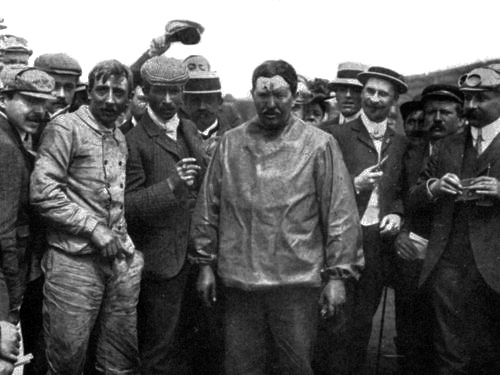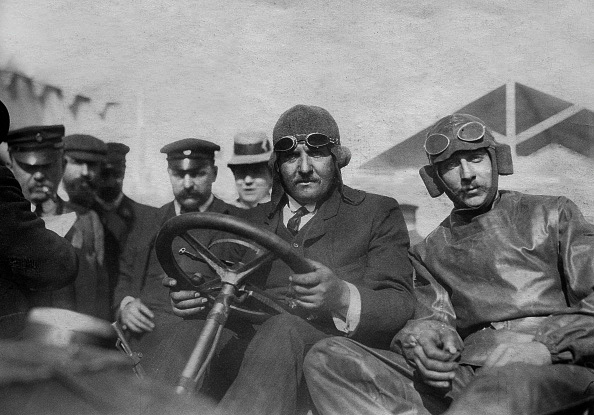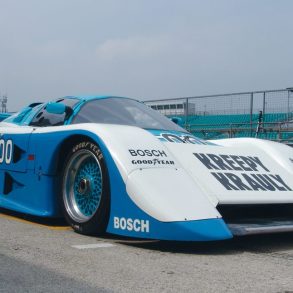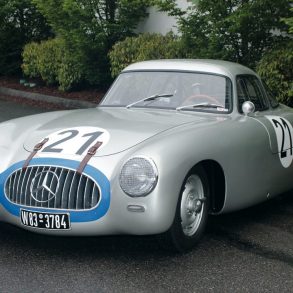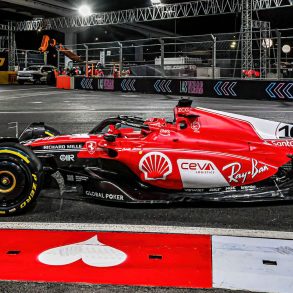Leon Thery Biography
Léon Théry was born in 1879. Having started out as a mechanic it was said that his mechanical knowledge helped him to understand the need to drive according to the car’s abilities, often nursing his car home to victory when others had fallen by the wayside. His first race was the Paris to Amsterdam in 1898 at the wheel of a voiturette. In 1900 he won the cup for voiturettes on the road from Bordeaux to Periguez and competed in several hill climbs. Most of his early racing was behind a Decauville, a French maker of locomotives.


The German government prepared an elaborate program of concerts, a grand open-air ballet and other events as part of a “Homburg Week” running from the 12th to the 23rd of June.
The 17th of June saw the day of the race and the weather could not be hotter. Officiating was led by Baron von Molitor of the Automobilclub von Deutschland, the official starter, and M. Tampier of the Automobile Club de France, who was the timekeeper. The chronographs for timing the event were supplied by the Anglo-Swiss firm of Stauffer, Son & Co. After the chaos at the Paris to Madrid race 5000 troops were requisitioned for keeping the Tanus course clear. There were 18 starters including three British entrants. The first car, that of the last years winner, Jenatzy started from Saalburg at 7 a.m.
With steam running from his radiator and in a cloud of trailing smoke Jenatzy was away followed in seven minute intervals by the rest of the field. Jenatzy was the first through Saalburg for the second lap but to his consternation Théry was already leading on time followed by Edge in third. Jenatzy would later remark that he never wanted to start first again as the leader on the road had the task of clearing the course on that first lap. Jenatzy was driving like a man possessed but still Théry was extending his lead. By the end of the second lap Théry knocked eleven seconds off his previous lap. On the third lap Théry broke one of the blades of his fan while Jenatzy stalled his car at Limburg. Théry’s lead was now 9 1/2 minutes. Jenatzy, totally exhausted was the first to finish not knowing whether he had won or lost. Finally a bugle blew and in the distance the Richard-Brasier of Leon Théry appeared. He had won at an average speed of 54.5 mph. With each of his laps within 3 minutes of the other he had earned his nickname of the “Chronometer”.
Third place went to the Turcat-Mery driven by Henri Rougier followed by the Mercedes of Baron Pierre de Caters and Edgar Braun. Two British competitors placed with the Wolseleys of Sidney Girling who finished 6th and that of Charles Jarrott who finished 12th or last. Australia’s Selwyn Edge, the 1902 winner who again drove a Napier, stopped at Idstein due to a seized engine.



The Brasiers of Théry and Gustave Callois were instructed to maintain a conservative pace. This appeared to doom their chances when the new F.I.A.T.s expanded their early lead, first place being held by Vincenzo Lancia. The Panhard of Maurice Farman missed a turn forcing a trip through the woods whereupon both driver and mechanic were thrown from their car only to be caught by some trees and perhaps certain death, Farman ending up higher than his mechanic. He pulled out a cigarette and looking down at his mechanic quietly remarked: “I wish you would pass me a match up, Tom.” Disaster struck on lap three however when Lancia’s engine froze. This left Théry in the lead, one that he would not relinquish. Second and third went to the F.I.A.T.s of Felice Nazzaro and Alessandro Cagno.
Théry retired from racing and turned to manufacturing his own car but this did not turn out well and nearly bankrupted him. In 1908 he attempted a comeback driving a Brasier in the French Grand Prix , but he retired on the last lap of the 10 lap race with a collapsed wheel. He was running fourth overall and first of the French cars. This was the last race of his career. Sadly one year later he was dead from tuberculosis. The two great drivers of their generation, Jenatzy and Théry could not be more different. One, Jenatzy being mercurial in the car and a practical joker out of it, the other, Théry calculating yet laconic.







